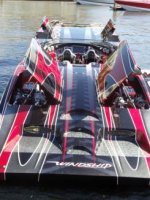RicardoMarine
Gold Medal Contributor
JJ, you seem to be irritated at the way in which this thread is going.
This is a forum where we are free to share ideas... yes/no?
Let's keep it civil and friendly.
1.... Am I not using a timing tab and a TDC mark also?
2.... This demands two responses.
a... if the timing tab is not accurate, it doesn't matter which style timing light we use. The timing will be as accurate or inaccurate as the marks are.
b... we then perform a PPS procedure.
3.... So, are you suggesting that a digitally advancing timing light has the miraculous capability of seeking out and finding true TDC without any reference points?
JJ, we cannot time any gasoline Marine engine without some form of crankshaft angle indicator. The TDC markings reference crankshaft angle relative to the cylinder being timed... of which is usually #1.
4.... In your opinion. As long as we're clear on that, we can agree.
.
This is a forum where we are free to share ideas... yes/no?
Let's keep it civil and friendly.
Being an engineer in the medical device field, I evaluate product risk on a daily basis.
1.... I can tell you that I'd feel more comfortable using that digital algorithm than the timing tab on your engine.
2.... How do you know the tab is aligned properly? How do you know that the monkey who owned the boat before you didn't replace it with the wrong timing tab?
3.... In my case, my stbd motor doesn't even have a timing tab.
4.... Comparing an adjustable timing light to a timing tab is like comparing a scientific calculator to an abacus.
-JJ
1.... Am I not using a timing tab and a TDC mark also?
2.... This demands two responses.
a... if the timing tab is not accurate, it doesn't matter which style timing light we use. The timing will be as accurate or inaccurate as the marks are.
b... we then perform a PPS procedure.
3.... So, are you suggesting that a digitally advancing timing light has the miraculous capability of seeking out and finding true TDC without any reference points?
JJ, we cannot time any gasoline Marine engine without some form of crankshaft angle indicator. The TDC markings reference crankshaft angle relative to the cylinder being timed... of which is usually #1.
4.... In your opinion. As long as we're clear on that, we can agree.
.
Last edited:


